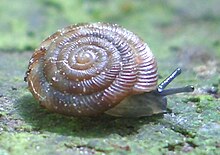Discus rotundatus
| Discus rotundatus | |
|---|---|
 |
|
| A live Discus rotundatus | |
| Scientific classification | |
| Kingdom: | Animalia |
| Phylum: | Mollusca |
| Class: | Gastropoda |
| (unranked): | clade Heterobranchia clade Euthyneura clade Panpulmonata clade Eupulmonata clade Stylommatophora informal group Sigmurethra |
| Superfamily: | Punctoidea |
| Family: | Discidae |
| Genus: | Discus |
| Subgenus: |
Gonyodiscus Fitzinger, 1833 |
| Species: | D. rotundatus |
| Binomial name | |
|
Discus rotundatus (O. F. Müller, 1774) |
|
| Synonyms | |
|
|
Discus rotundatus, common name Rotund Disc, is a species of small, air-breathing, land snail, a terrestrial pulmonate gastropod mollusk in the family Discidae, the disk snails.
The shells of Discus rotundatus in the adult stage measure 5.7–7 millimetres (0.22–0.28 in) in diameter and 2.4–6 millimetres (0.094–0.236 in) in height. Shells are reddish brown with darker cross bands, flat and densely ribbed. The umbilicus is quite wide, reaching about 1/3 of the shell diameter.
Among the species of Discus in Europe and North America, Discus rotundatus is recognized by the alternating pattern of reddish brown spots, tight coiling of the whorls and broad and shallow umbilicus.
The body of this gastropod is bluish black on the upperside, while the lower side is greyish white. They mainly feed on plant debris, humus, algae and fungi.
These snails, like most terrestrial gastropods, are hermaphrodite. The reproductive season last from May to October. Usually they lay 20-50 eggs in rotting wood or below decaying leaves. Eggs are white and flattened, measure about 1 mm and hatch after 10–30 days. These gastropods reach their maturity only in the second or third season and can live 2–3 years. Unlike many terrestrial snails they do not have a sex dart.
This species lives in Western and Central Europe. It is found in the Czech Republic, Poland, Ukraine and Slovakia. It is also found in Great Britain, Ireland, France, Italy, southern Scandinavia, and other countries. Its range includes Turkey.
...
Wikipedia
